

Microchip PIC系列8位单片机入门教程(6)ADC
控制/MCU
描述
第一节 知识点
1.ADC
(1)10 位模数转换器(A/D)模块:28 引脚器件的模数(Analog-to-DigitalA/D)转换器具有10 路输入,而40/44 引脚器件的模数转换器则具有13 路输入。A/D 模块能将一个模拟输入信号转换成相应的10 位数字信号。
(2)此模块有五个寄存器:
• A/D 转换结果高位寄存器(ADRESH)
• A/D 转换结果低位寄存器(ADRESL)
• A/D 转换控制寄存器0 (ADCON0):A/D 模块的工作方式由ADCON0寄存器控制。
• A/D 转换控制寄存器1 (ADCON1):端口引脚的功能由ADCON1 寄存器配置。
• A/D 转换控制寄存器2 (ADCON2):由ADCON2 寄存器配置A/D 时钟源,编程采集时间和对齐方式。
(3)执行A/D 转换时应该遵循以下步骤:
- 配置A/D 模块:
• 配置模拟引脚、参考电压和数字I/O (通过ADCON1 寄存器)
• 选择A/D 输入通道(通过ADCON0 寄存器)
• 选择A/D 采集时间(通过ADCON2 寄存器)
• 选择A/D 转换时钟(通过ADCON2 寄存器)
• 使能A/D 模块(通过ADCON0 寄存器) - 需要时,配置A/D 中断:
• 清零ADIF 位
• 将ADIE 位置1
• 将GIE 位置1 - 如果需要,等待所需的采集时间。
- 启动转换:
• 将GO/DONE 位置1 (ADCON0 寄存器) - 等待A/D 转换完成,通过以下两种方法之一判断转换是否完成:
• 查询GO/DONE 位是否被清零或 等待A/D 中断 - 读取A/D 结果寄存器(ADRESH:ADRESL),需要时将ADIF 位清零。
- 如需再次进行A/D 转换,返回步骤1 或步骤2。将每位的A/D 转换时间定义为TAD,在下一次采集开始前至少需要等待2 个TAD。
(4)A/D 采集要求
为了使A/D 转换器达到规定精度,必须使充电保持电容(CHOLD)充满至输入通道的电平。图19-3 给出了模拟输入的电路模型。电源阻抗(RS)和内部采样开关阻抗(RSS)直接影响电容CHOLD 充电的时间。采样开关(RSS)阻抗值随器件电压(VDD)不同而改变。电源阻抗将影响模拟输入的偏移电压(由于引脚泄漏电流的原因)。模拟信号源的最大阻抗推荐值为2.5 kΩ。在选择(改变)了模拟输入通道之后,必须对通道进行采样才能启动转换,采样时间必须大于最小采集时间。
(5) 采样时间计算:
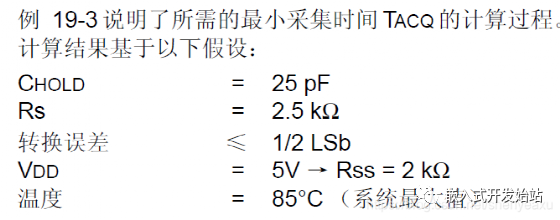
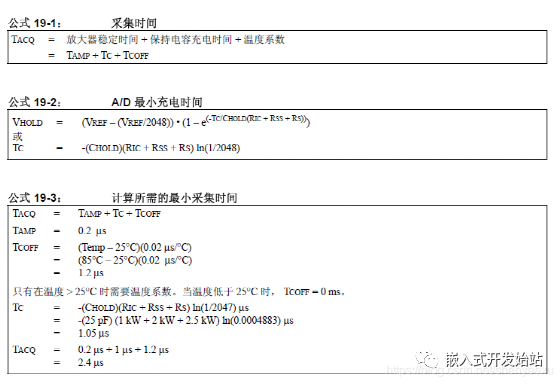
1.ADC的原理框图: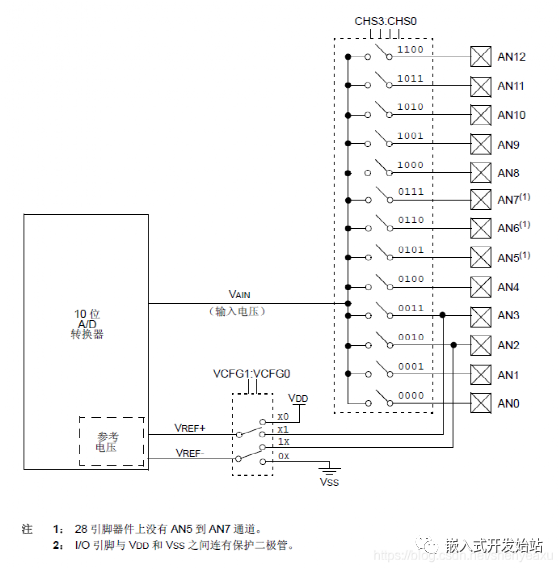
2.与ADC相关的寄存器: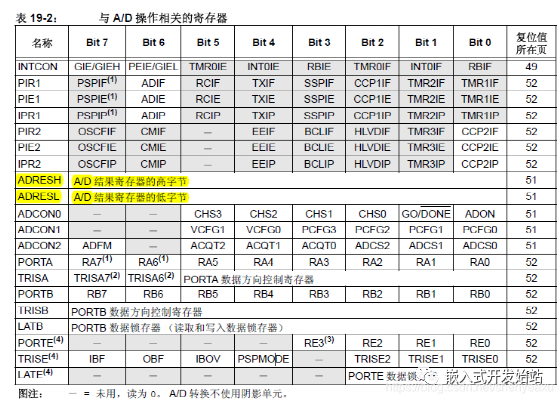

我们设置VCFG1=0,采用BSS作为参考电压VREF-;
设置VCFG0=0,采用VDD作为VREF+的参考电压。
配置PCFG3:PCFG0 进行采集模拟量的端口配置。
配置ADFM,ADC转化结构的格式是左对齐还是右对齐,这是因为ADC转化结果是10位的需要两个8位寄存器存储。
ACQT2:ACQT0:A/D 采集时间选择位;
ADCS2:ADCS0:A/D 转换时钟选择位。
3.比如我们在实际中要采集电压,典型的电路图如下: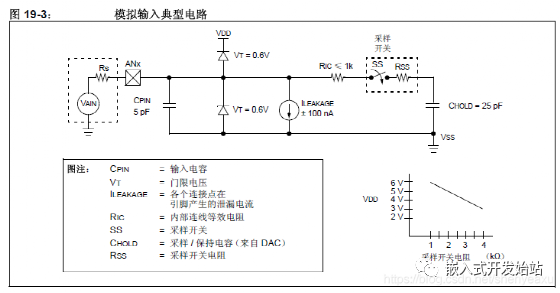
02第二节 代码设计
1.我们新建两个文件:
(1) adc_sample.h
/* Microchip Technology Inc. and its subsidiaries. You may use this software
* and any derivatives exclusively with Microchip products.
* File: adc_sample.h
* Author: Greg
* Comments:
* Revision history: 2018-06-21
*/
// This is a guard condition so that contents of this file are not included
// more than once.
#ifndef _ADC_SAMPLE_H_
#define _ADC_SAMPLE_H_
#include // include processor files - each processor file is guarded.
#define Channel_0_ON 0b0000
#define Channel_1_ON 0b0001
#define Channel_2_ON 0b0010
#define Channel_3_ON 0b0011
#define Channel_4_ON 0b0100
#define Channel_5_ON 0b0101
#define Channel_6_ON 0b0110
#define Channel_7_ON 0b0111
#define ADC_Channel_select ADCON0bits.CHS
#define ADC_ENABLE ADCON0bits.ADON=1
#define ADC_DISABLE ADCON0bits.ADON=0
#define ADC_STATUS ADCON0bits.GODONE
#define ADC_START ADCON0bits.GO=1
#define ADC_PORT_DIR TRISA
void ADC_Channel_config(void);
double ADC_Converter_Ddecimal(unsigned int ADC_data);
double ADC_Process_show(unsigned char Channel_selected );
double ADC_Process_Select_work(unsigned char Channel_selected);
#endif /* XC_HEADER_TEMPLATE_H */
(2)adc_sample.c
#include
#include "adc_sample.h"
static unsigned int ADC_Data[8]=0;
void ADC_Channel_config(void)
{
ADC_PORT_DIR=0xFF;
ADCON1bits.PCFG=0b0111; //select An0-An7 Channel to A_D converter
ADCON1bits.VCFG=0b00; //voltage reference for Vss,Vdd.
ADCON2bits.ADFM=1; // reslut right justed
ADCON2bits.ACQT=0b001;
ADCON2bits.ADCS=0b000;
}
/*
this fucntion is to converter result of ADC to decimal result.
*/
double ADC_Converter_Ddecimal(unsigned int ADC_data)
{ double temp;
temp=(double) ADC_data*5.0;
return temp/1023.0;
}
/*
* This is first way to get ADC sample Result.
*/
double ADC_Process_show(unsigned char Channel_selected)
{
double ADC_temp0=0;
switch (Channel_selected){
case 0:
ADC_Channel_select=Channel_0_ON;
break;
case 1:
ADC_Channel_select=Channel_1_ON;
break;
case 2:
ADC_Channel_select=Channel_2_ON;
break;
case 3:
ADC_Channel_select=Channel_3_ON;
break;
case 4:
ADC_Channel_select=Channel_4_ON;
break;
case 5:
ADC_Channel_select=Channel_5_ON;
break;
case 6:
ADC_Channel_select=Channel_6_ON;
break;
case 7:
ADC_Channel_select=Channel_7_ON;
break;}
ADC_ENABLE;
ADC_START;
while(ADC_STATUS);
// ADC_Data[0]=0x00FF&ADRESL;
// ADC_Data[0]|=ADRESH< < 8;< span="" >
ADC_Data[0]=ADRES;
ADC_temp0=ADC_Converter_Ddecimal(ADC_Data[Channel_selected]);
return ADC_temp0;
}
/*
* This is second way to get ADC sample Result.
*/
double ADC_Process_Select_work(unsigned char Channel_selected)
{ double ADC_temp0=0;
ADC_Channel_select=Channel_selected;
ADC_ENABLE;
ADC_START;
while(ADC_STATUS);
// ADC_Data[0]=0x00FF&ADRESL;
// ADC_Data[0]|=ADRESH< < 8;< span="" >
ADC_Data[0]=ADRES;
ADC_temp0=ADC_Converter_Ddecimal(ADC_Data[0]);
return ADC_temp0;
}
(3)main.C
// PIC18F4520 Configuration Bit Settings
// 'C' source line config statements
// Author:Greg
// Title:ADC 采样
// CONFIG1H
#pragma config OSC = HS // Oscillator Selection bits (HS oscillator)
#pragma config FCMEN = OFF // Fail-Safe Clock Monitor Enable bit (Fail-Safe Clock Monitor disabled)
#pragma config IESO = OFF // Internal/External Oscillator Switchover bit (Oscillator Switchover mode disabled)
// CONFIG2L
#pragma config PWRT = OFF // Power-up Timer Enable bit (PWRT disabled)
#pragma config BOREN = SBORDIS // Brown-out Reset Enable bits (Brown-out Reset enabled in hardware only (SBOREN is disabled))
#pragma config BORV = 3 // Brown Out Reset Voltage bits (Minimum setting)
// CONFIG2H
#pragma config WDT = OFF // Watchdog Timer Enable bit (WDT disabled (control is placed on the SWDTEN bit))
#pragma config WDTPS = 32768 // Watchdog Timer Postscale Select bits (1:32768)
// CONFIG3H
#pragma config CCP2MX = PORTC // CCP2 MUX bit (CCP2 input/output is multiplexed with RC1)
#pragma config PBADEN = ON // PORTB A/D Enable bit (PORTB< 4:0 >pins are configured as analog input channels on Reset)
#pragma config LPT1OSC = OFF // Low-Power Timer1 Oscillator Enable bit (Timer1 configured for higher power operation)
#pragma config MCLRE = OFF // MCLR Pin Enable bit (RE3 input pin enabled; MCLR disabled)
// CONFIG4L
#pragma config STVREN = OFF // Stack Full/Underflow Reset Enable bit (Stack full/underflow will not cause Reset)
#pragma config LVP = OFF // Single-Supply ICSP Enable bit (Single-Supply ICSP disabled)
#pragma config XINST = OFF // Extended Instruction Set Enable bit (Instruction set extension and Indexed Addressing mode disabled (Legacy mode))
// CONFIG5L
#pragma config CP0 = OFF // Code Protection bit (Block 0 (000800-001FFFh) not code-protected)
#pragma config CP1 = OFF // Code Protection bit (Block 1 (002000-003FFFh) not code-protected)
#pragma config CP2 = OFF // Code Protection bit (Block 2 (004000-005FFFh) not code-protected)
#pragma config CP3 = OFF // Code Protection bit (Block 3 (006000-007FFFh) not code-protected)
// CONFIG5H
#pragma config CPB = OFF // Boot Block Code Protection bit (Boot block (000000-0007FFh) not code-protected)
#pragma config CPD = OFF // Data EEPROM Code Protection bit (Data EEPROM not code-protected)
// CONFIG6L
#pragma config WRT0 = OFF // Write Protection bit (Block 0 (000800-001FFFh) not write-protected)
#pragma config WRT1 = OFF // Write Protection bit (Block 1 (002000-003FFFh) not write-protected)
#pragma config WRT2 = OFF // Write Protection bit (Block 2 (004000-005FFFh) not write-protected)
#pragma config WRT3 = OFF // Write Protection bit (Block 3 (006000-007FFFh) not write-protected)
// CONFIG6H
#pragma config WRTC = OFF // Configuration Register Write Protection bit (Configuration registers (300000-3000FFh) not write-protected)
#pragma config WRTB = OFF // Boot Block Write Protection bit (Boot block (000000-0007FFh) not write-protected)
#pragma config WRTD = OFF // Data EEPROM Write Protection bit (Data EEPROM not write-protected)
// CONFIG7L
#pragma config EBTR0 = OFF // Table Read Protection bit (Block 0 (000800-001FFFh) not protected from table reads executed in other blocks)
#pragma config EBTR1 = OFF // Table Read Protection bit (Block 1 (002000-003FFFh) not protected from table reads executed in other blocks)
#pragma config EBTR2 = OFF // Table Read Protection bit (Block 2 (004000-005FFFh) not protected from table reads executed in other blocks)
#pragma config EBTR3 = OFF // Table Read Protection bit (Block 3 (006000-007FFFh) not protected from table reads executed in other blocks)
// CONFIG7H
#pragma config EBTRB = OFF // Boot Block Table Read Protection bit (Boot block (000000-0007FFh) not protected from table reads executed in other blocks)
// #pragma config statements should precede project file includes.
// Use project enums instead of #define for ON and OFF.
#include
#include "adc_sample.h"
#include
#include "usart_dr.h"
//#include"plib/adc.h"
//#include "delays.h"
int main(void)
{
unsigned char Channel_select=0;
double ADC_temp0;
ADC_Channel_config();
usart_port_dir_init();
usart_Config_init();
printf("test for printf functionrtn"); // printf 函数实现成功!
printf("ADC 采样实现rtn"); // printf 函数实现成功!
while(1)
{
ADC_temp0=ADC_Process_show(Channel_select);
printf("ADC var:%frtn",ADC_temp0);
ADC_temp0=ADC_Process_Select_work(Channel_0_ON);
printf("ADC var:%frtn",ADC_temp0);
}
return 0;
}
下载到开发板中看效果吧,代码的注释很清楚我就不解释了。
-
Microchip PIC系列8位单片机入门教程(2):点亮LED灯2023-07-14 4764
-
PIC系列单片机2021-11-16 2440
-
Microchip推出两个全新PIC单片机系列2015-07-21 2144
-
Microchip推出首款集成16位ADC、10 Msps ADC、 DAC、USB和LCD的PIC单片机2013-09-17 13014
-
Microchip扩展通用8位PIC单片机系列2013-05-15 2021
-
Microchip发布6至20引脚的全新8位PIC单片机2011-09-29 2095
-
Microchip推出全新的8位PIC单片机2011-09-28 7590
-
PIC单片机图解入门教程2011-05-26 2186
-
PIC 8位单片机的特点2010-09-23 457
-
PIC 8位单片机的分类和特点2010-03-27 2299
-
Microchip推出多款全新8位PIC单片机2010-03-10 911
-
PIC 8位单片机16C6×系列简介2009-08-14 1944
-
单片机入门教程2006-03-21 2746
-
微芯科技出8位闪存 PIC单片机新增片上ADC2006-03-13 1256
全部0条评论

快来发表一下你的评论吧 !

